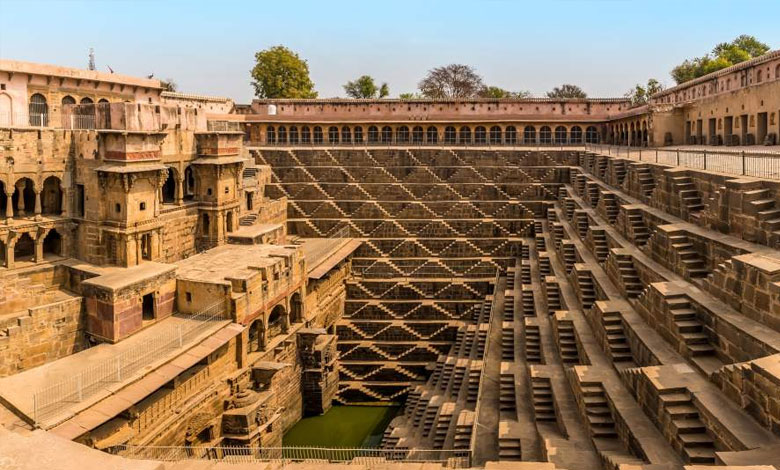10 beautiful stepwells in India worth appreciating

India is a country with magnificent natural spectacles and bewildering architecture. Besides, there are some edifices which were long forgotten but are now gaining attention. These are the stepwells. Step-well or baori is a manmade structure resembling a pond. These large reservoirs of water consist of stairs or steps that descend to the pond and were built for the purpose of rainwater harvesting, water supply and baths. The stepwells in India were found in the regions prone to profound shortages of water like Rajasthan, Gujarat, Delhi.
However, there were reportedly several thousand before the British came to India. Sadly, they lost their purpose after piped systems were installed. Yet, most stepwells in India were subsequently destroyed or neglected; there are still some that are well-maintained and worth appreciating. Here’s our pick of the most spectacular stepwells in India which have the proficiency to submerge you in their captivating beauty.
1. Rani-ki-vav, Patan, Gujarat
Rani Ki Vav or the queen’s step-well is a UNESCO world heritage site in Patan, Gujarat. It was constructed in the 11th century by Queen Udayamati in the memory of her husband, King Bhimdev. However, the baori was earlier flooded by the River Saraswati and silted over. Later it was excavated by archaeologists in the late 1980s. The unique feature of this one of the largest step-wells is there is no stone left uncarved. There are more than 1500 major and minor sculptures on the panels of the elaborate step well, which was designed as an inverted temple. Another highlight of the this one of the beautiful stepwells in india is that there was even an escape route for the royal family on the bottom level of the step well.
2. Adalaj ni vav, Adalaj, Gujarat
The elegant five-story step well at Adalaj near Ahmedabad in Gujarat is one of the most famous stepwells in India. The walls of this stepwell describe a tragic story behind its inception. Rana Veer Singh, of the Vaghela dynasty of Dandai Desh was building this stepwell for his beautiful wife Rani Roopba. The construction of the step well was left incomplete when King Muḥammad Begda killed Rana Veer Singh in an invasion. King Muḥammad convinced Rana Veer Singh’s widow Rani Roopba to marry him, on the condition that he’d finish the well. After the well was built, she committed suicide by jumping into it. The step well’s Indo-Islamic architecture represents a masterpiece of the stonemason’s art with walls adorned with carvings of elephants, mythological scenes of Hindu deities and symbolism.
3. Chand Baori, Abhaneri, Rajasthan
Chand Baori or popularly known as Abhaneri stepwell is in Abhaneri village, in the Dausa district of Rajasthan. The stepwell is said to be the oldest, deepest and largest stepwells in India which extends approximately 100 feet into the ground, down 3,500 steps and 13 levels. It is a magnificent but rather astonishing stepwell with diagonal steps descending into the well from all sides giving the baori a sense of unbelievable geometry. The stepwell features a sequence of royal gazebos, with resting rooms atop each other for the kings and queens at the north. They’re enveloped by crisscross steps on the other three sides. There’s also a partially-ruined shrine, dedicated to Harshat Mata, connecting the stepwell. If you’re a movie fanatic, you might recognize the stepwell from the Batman movie The Dark Knight Rises. There many other stepwells in Jaipur that are worth admiring.
4. Toor Ji Ka Jhalra, Jodhpur, Rajasthan
The step-well is locally known as ‘jhalra’ in Jodhpur. Toor Ji ka Jhalra is a wonderful, decent step-well said to be constructed in the early 18th century. It is situated in the heart of Jodhpur’s Old City, where it’s one of the top attractions. This red sandstone stepwell was built by the wife of Maharaja Abhay Singh but was sadly submerged and filled with garbage. After it was revived recently, the stepwell is hailed as a remarkable example of urban rehabilitation. The area around the stepwell has also been transformed into what’s now called StepWell Square. It features modern cafes and shops housed in the heritage buildings. It has a heritage hotel near to it with a StepWell Suite where you’ll get an explicit view over the monument.
5. Agrasen Ki Baoli, New Delhi
Agrasen ki Baoli is the most often-missed Delhi landmark that opens up abruptly in the middle of a crowded Delhi street close to Jantar Mantar. The 60-meter long stepwell was most likely constructed during the Tughlaq period in the 14th century when Delhi was ruled by a dynasty of Turkic sultans. It has been constructed by King Agrasen during the Mahabharata period and then later rebuilt in the 14th century by the Agrawal community, who are descendants of the King. It has been restored recently by the Archaeological Survey of India to maintain the stepwell. The step well’s 100-plus stairs used to be submerged in water but these days it’s completely dried up and you can walk down, past the chambers and passageways, to the deepest point. However, today, the baoli is a youths favorite picnic spot as well as selfie spot because of being shot for blockbuster PK.
6. Rajon Ki Baoli, Delhi
Rajon ki Baoli is the stepwell located deep inside the dry forest around lush Mehrauli Archaeological Park. While the well’s name indicates a link with Indian royalty (‘Raja’ is another word for king), it is actually named after rajmistris or rajons (masons who built it) that occupied it in the early 1900s. It was built in the 16th century by Daulat Khan, a leading official in the government of Delhi’s Lodi Dynasty. The architecture of the stepwell is undoubtedly Islamic, with stone stairs descending into the deep waters of Rajon Ki Baoli stepwell in Delhi. The surrounding stone walls are in tier shape, with built-in archways and adorned with Islamic stucco motifs. The stepwell has stories of ghosts that have grown up around this strangely quiet site, which overflows with scarred mosques, tombs and pavilions.
7. Pushkarini, Hampi, Karnataka
Hampi Pushkarini is a stepwell which is a stepped square shaped step well known for its Chalukyas architecture. Built out of chloritic schist blocks, the pushkarini is remarkable for its geometric proportions. Stairs cascade down the walls of the well from all sides, down to a small pool of blue water in the centre. Stepwells are mainly a northern tradition, but the ruins at Hampi are marked with ceremonial stepwells, or pushkarinis, that are built in the stepwell style. Within the royal enclosure, the classic Indian stepwell, although stripped of its upper pavilions, has an eye-catching cascade of pyramid-shaped stairways still intact. This stepwell is a clear glimpse of the lifestyles of Hampi’s ancient rulers.
8. Lakkundi Kalyanis, Hampi, Karnataka
Lakkundi is a small village in Hampi having more than 100 stepwells, all outstanding in their own way. The Stepwells in Karnataka are locally known as Pushkarini or Kalyani. Although the stepwell here are not as flamboyant as in Rajasthan and Gujarat, they are artistically designed and endearing. Lakkundi Kalyanis also known as Muskin Bhanvi is an obscure yet exquisite 12th-century stepwell located at the village of Lakkundi in Hampi. The stepwell is connected to Manikesvara temple and extends outwards from underneath the temple, and there are several shrines within its steps.
9. Surya Kund, Modhera, Gujarat
Surya Kund is a stepwell on the eastern edge of Sun temple at Modhera in Gujarat. The Surya Kund faces the Sabha Mandap studded with more than 100 small shikharas and shrines. It looks like a sunken art gallery of carved stone. The 11th-century stepwell has pyramid-shaped steps forming some intriguing geometric patterns on the steps. These are a stylized mirror-image of the Shikhara that unfortunately no longer exists. There is a temple of Vishnu on Shesh Shaiya on the step directly opposite the temple. There are temples dedicated to Ganesha, Shiva as Nataraja and Shitlamata, the goddess of Chicken Pox. Other temples are in different stages of ruin, but they all look beautiful even now. It is also said that turtles still reside in the waters of this stepwell.
10. Raniji Ki Baoli, Bundi, Rajasthan
Raniji Ki Baoli also known as ‘Queen’s Stepwell’ is an ancient stepwell in Bundi, Rajasthan. It was constructed under Queen Nathavati in the 17th century and boasts striking architecture. The baoli has a narrow gateway lined with four sturdy pillars and slender arches on the high roof. A flight of stairs descends into a part well, part temple and part palace with limited water reserves. Bundi is also popular as the city of stepwells as there are supposed to be around 50 Baoris in Bundi. Queen Nathwati herself built 21 of those stepwells. Of them all, Raniji Ki Baoli is an important heritage monument of the city.
Each of the above-mentioned stepwells in India is either a significant structure of its era or is revered for its magnificent architecture. A lot of the stepwells live a forgotten life and have run dry, but they are vital edifices which convey a lot about their respective ages.




